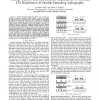Free Online Productivity Tools
i2Speak
i2Symbol
i2OCR
iTex2Img
iWeb2Print
iWeb2Shot
i2Type
iPdf2Split
iPdf2Merge
i2Bopomofo
i2Arabic
i2Style
i2Image
i2PDF
iLatex2Rtf
Sci2ools
ASPDAC
2009
ACM
2009
ACM
Timing analysis and optimization implications of bimodal CD distribution in double patterning lithography
Abstract— Double patterning lithography (DPL) is in current production for memory products, and is widely viewed as inevitable for logic products at the 32nm node. DPL decomposes and prints the shapes of a critical-layer layout in two exposures. In traditional single-exposure lithography, adjacent identical layout features will have identical mean critical dimension (CD), and spatially correlated CD variations. However, with DPL, adjacent features can have distinct mean CDs, and uncorrelated CD variations. This introduces a new set of ‘bimodal’ challenges for timing analysis and optimization. We assess the potential impact of DPL on timing analysis error and guardbanding, and find that the traditional ‘unimodal’ characterization and analysis framework may not be viable for DPL. For example, using 45nm models, we find that different DPL mask layout solutions can cause 50ps skew in clock distribution that is unseen by traditional analyses. Different mask layouts can also resu...
| Added | 28 May 2010 |
| Updated | 28 May 2010 |
| Type | Conference |
| Year | 2009 |
| Where | ASPDAC |
| Authors | Kwangok Jeong, Andrew B. Kahng |
Comments (0)

